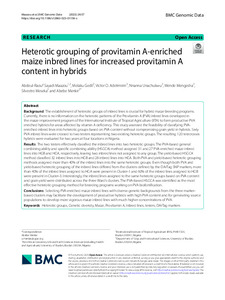| dc.contributor.author | Sayadi Maazou, A.R. |
| dc.contributor.author | Gedil, M. |
| dc.contributor.author | Adetimirin, V. |
| dc.contributor.author | Unachukwu, N. |
| dc.contributor.author | Mengesha Abera, W. |
| dc.contributor.author | Meseka, S.K. |
| dc.contributor.author | Menkir, A. |
| dc.date.accessioned | 2023-10-24T10:38:47Z |
| dc.date.available | 2023-10-24T10:38:47Z |
| dc.date.issued | 2023-09-27 |
| dc.identifier.citation | Sayadi Maazou, A.R., Gedil, M., Adetimirin, V., Unachukwu, N., Mengesha Abera, W., Meseka, S.K., & Menkir, A. (2023). Heterotic grouping of provitamin A-enriched maize inbred lines for increased provitamin A content in hybrids. MBC Genomic Data, 24:57, 1-8. |
| dc.identifier.issn | 2730-6844 |
| dc.identifier.uri | https://hdl.handle.net/20.500.12478/8308 |
| dc.description.abstract | Background The establishment of heterotic groups of inbred lines is crucial for hybrid maize breeding programs. Currently, there is no information on the heterotic patterns of the Provitamin A (PVA) inbred lines developed in the maize improvement program of the International Institute of Tropical Agriculture (IITA) to form productive PVA enriched hybrids for areas affected by vitamin A deficiency. This study assessed the feasibility of classifying PVA-enriched inbred lines into heterotic groups based on PVA content without compromising grain yield in hybrids. Sixty PVA inbred lines were crossed to two testers representing two existing heterotic groups. The resulting 120 testcrosses hybrids were evaluated for two years at four locations in Nigeria. Results The two testers effectively classified the inbred lines into two heterotic groups. The PVA-based general combining ability and specific combining ability (HSGCA) method assigned 31 and 27 PVA enriched maize inbred lines into HGB and HGA, respectively, leaving two inbred lines not assigned to any group. The yield-based HSGCA method classified 32 inbred lines into HGB and 28 inbred lines into HGA. Both PVA and yield-based heterotic grouping methods assigned more than 40% of the inbred lines into the same heterotic groups. Even though both PVA and yield-based heterotic grouping of the inbred lines differed from the clusters defined by the DArTag SNP markers, more than 40% of the inbred lines assigned to HGA were present in Cluster-1 and 60% of the inbred lines assigned to HGB were present in Cluster-3. Interestingly, the inbred lines assigned to the same heterotic groups based on PVA content and grain yield were distributed across the three Ward’s clusters. The PVA-based HSGCA was identified as the most effective heterotic grouping method for breeding programs working on PVA biofortification. Conclusions Selecting PVA enriched maize inbred lines with diverse genetic backgrounds from the three marker-based clusters may facilitate the development of productive hybrids with high PVA content and for generating source populations to develop more vigorous maize inbred lines with much higher concentrations of PVA. |
| dc.description.sponsorship | African Union |
| dc.description.sponsorship | Bill & Melinda Gates Foundation |
| dc.format.extent | 1-8 |
| dc.language.iso | en |
| dc.subject | Heterotic Groups |
| dc.subject | Genetic Diversity |
| dc.subject | Maize |
| dc.subject | Provitamins |
| dc.subject | Inbred Lines |
| dc.title | Heterotic grouping of provitamin A-enriched maize inbred lines for increased provitamin A content in hybrids |
| dc.type | Journal Article |
| cg.contributor.crp | Maize |
| cg.contributor.affiliation | University of Ibadan |
| cg.contributor.affiliation | International Institute of Tropical Agriculture |
| cg.coverage.region | Africa |
| cg.coverage.region | West Africa |
| cg.coverage.country | Nigeria |
| cg.coverage.hub | Headquarters and Western Africa Hub |
| cg.researchtheme | Biotech and Plant Breeding |
| cg.identifier.bibtexciteid | SAYADIMAAZOU:2023 |
| cg.isijournal | ISI Journal |
| cg.authorship.types | CGIAR and developing country institute |
| cg.iitasubject | Agronomy |
| cg.iitasubject | Food Security |
| cg.iitasubject | Maize |
| cg.iitasubject | Plant Breeding |
| cg.iitasubject | Plant Production |
| cg.journal | BMC Genomic Data |
| cg.notes | Open Access Journal; Published online: 27 Sep 2023 |
| cg.accessibilitystatus | Open Access |
| cg.reviewstatus | Peer Review |
| cg.usagerightslicense | Creative Commons Attribution 4.0 (CC BY 0.0) |
| cg.targetaudience | Scientists |
| cg.identifier.doi | https://doi.org/10.1186/s12863-023-01156-z |
| cg.iitaauthor.identifier | Melaku Gedil: 0000-0002-6258-6014 |
| cg.iitaauthor.identifier | Nnanna Unachukwu: 0000-0003-2701-2477 |
| cg.iitaauthor.identifier | Wende Mengesha: 0000-0002-2239-7323 |
| cg.iitaauthor.identifier | SILVESTRO MESEKA: 0000-0003-1004-2450 |
| cg.iitaauthor.identifier | Abebe Menkir: 0000-0002-5907-9177 |
| cg.futureupdate.required | No |
| cg.identifier.issue | 57 |
| cg.identifier.volume | 24 |
| cg.contributor.acknowledgements | The authors are grateful for the technical support of the staff of the Maize Improvement Program, the Food and nutrition laboratory, and the Bioscience Center at IITA in Ibadan, Nigeria. We also acknowledge Oluyinka Ilesanmi for his support during the leaf sample preparation and shipment for DArTag genotyping. |

